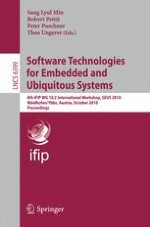The 8th IFIP Workshop on Software Technologies for Embedded and Ubiq- tous Systems (SEUS 2010) in Waidhofen/Ybbs, Austria, October 13-15, 2010, succeeded the seven previous workshops in Newport Beach, USA (2009); Capri, Italy (2008); Santorini, Greece (2007); Gyeongju, Korea (2006); Seattle, USA (2005); Vienna, Austria (2004); and Hokodate, Japan (2003); installing SEUS as a successfully established workshop in the ?eld of embedded and ubiquitous systems. SEUS 2010 continued the tradition of fostering cross-community scienti?c excellence and establishing strong links between research and industry. SEUS 2010 provided a forum where researchers and practitioners with substantial - periences and serious interests in advancing the state of the art and the state of practice in the ?eld of embedded and ubiquitous computing systems gathered with the goal of fostering new ideas, collaborations, and technologies. The c- tributions in this volume present advances in integrating the ?elds of embedded computing and ubiquitous systems. The call for papers attracted 30 submissions from all around the world. Each submission was assigned to at least four members of the Program Committee for review. The Program Committee decided to accept 21 papers, which were arranged in eight sessions. The accepted papers are from Austria, Denmark, France, Germany, Italy, Japan, Korea, Portugal, Taiwan, UK, and USA. Two keynotes complemented the strong technical program.
